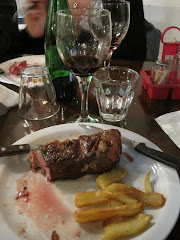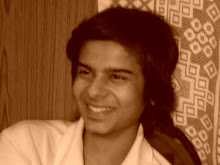This post was written on Wednesday, 24th of June.
Delay due to laptop problems..
Before coming to Buenos Aires, I was dreading the fact that it would be winter during my time here. After about 5 months of cold weather in New Haven, and then a month of sunlight, I cursed the fact that Buenos Aires was in the southern hemisphere. However, on getting here, I found that the winter here was nothing like the winter that I experienced in New England. That is, till today. I stepped out of the house at 8:15 in the morning to be greeted with a gush of wind and a temperature of 1 degree celsius. Luckily I had been forewarned by my host father about the terrible weather, and was suitable dressed, donning my white beanie, as well as my pea coat, which I had not previously used here. What is a relief, however, is that it can only get better from now on (marginally at least), as today was supposed to be the coldest day of the year here.
I am two days late with this entry, the reason being that over the extended weekend, I made a trip to Uruguay, and since coming back, I have had to catch up on work that I had previously ignored. A small price to pay for the great time I had over the weekend.
Over the last half a year, I had been in touch with the AIESEC chapter in Montevideo to try to create a partnership with Yale to send Yalies to do internships there. This partnership succeeded, and we ended up sending two Yalies to do internships during the summer vacations. As such, I got in touch with AIESECers from Montevideo and told them about my visit, and they enthusiastically offered to put me up and show me around. I set off for Montevideo on Friday evening by boat, and on arrival, was greeted by John, a Yalie doing an AIESEC internship there, along with 2 Uruguayan AIESECers who were waiting for me at the station. They drove me to the local committee president, Alejandro’s family’s apartment, where I was to spend the night. Alejandro’s family greeted me warmly, and they seemed pretty used to having strangers from random countries arrive at their doorstep. Some more AIESECers arrived, and we hung out and talked over beers (which I actually somehow liked). We then proceeded to a bar, where there were more AIESECers: trainees doing internships from all parts of the world, as well as the local AIESECers from Montevideo. All conversation was conducted in Spanish, which was great. Everyone seemed to be pretty intrigued by India, and had many questions, and I tried my best to explain the caste system in Spanish. Another common question, which I have got from most people when I meet them, is whether I have seen Slumdog Millionaire, and what I thought of it. My reply would often be, ‘of course, I was in it!’, which would cause ‘wows!’ and ‘reallys?’. My first joke in Spanish. And my second, and third…
The following day some of my friends from my study abroad program arrived in Montevideo, and we checked into a hostel in the center of the city. With John guiding us, we roamed most of the city. Montevideo isn’t really a city of spectacular sights. The most notable one, is ‘Mercado del Puerto’, or market of the port. It consists of a number of stores and traditional restaurants housed in an old warehouse next to the sea. We had lunch there, and ordered a big plate of meat. It turned out to be the most meat I’ve ever eaten at a meal. The dish that came had every single body part of an animal that you could think of, from intestines to liver to thymus. Check out the picture attached! As for the city of Montevideo itself, I wasn’t too impressed. On both Saturday and Sunday, most streets were deserted. Granted, it was terrible weather (raining), and it was an extended weekend, which gave many people the opportunity to get out of the city to travel, but it seemed more like a ghost city. Used to the bustling streets of Buenos Aires, this was a world apart. Though the capital cities of the two countries may seem totally different, Argentina and Uruguay share much in terms of culture. The food in both countries is pretty much identical. You greet everyone with a kiss on the cheek. Both countries share the ‘rioplatense’ Spanish accent, where all ‘ll’s are pronounced as ‘sh’s, and you say ‘vos’ instead of ‘tu’ for ‘you’. In terms of measures of wealth, such as GDP per capita etc, both countries are equally well off (or not well off) as each other, though it may not seem so if you take Buenos Aires to be representative of Argentina (which it is not).
Sunday morning I woke up after barely 5 hours of sleep to head to a slum just outside the city with John and some other local AIESECers. We went as volunteers for an NGO, ‘Techos para mi País’ (Roofs for my country), which exists in most countries in Latin America, and works to construct houses in slums for the underprivileged. The weekend before I arrived, a number of AIESECers had volunteered to spend their weekend building and reconsolidating houses in the slum. This weekend was a more relaxed trip, with the aim of just visiting the families for whom the houses had been built. Because of the continuous rain, the ground in the slum had been turn into a slush pit, with trash strewed everywhere, and dogs running to and fro. The major problems in the slum are sanitation and health. Though most inhabitants have gotten at least high school education (it is free and compulsory in Uruguay), and almost all houses have TVs, basic knowledge of health is lacking, with children growing up not being taught to brush their teeth, and no doctors in the vicinity. We spent a few hours chatting with the family in their newly built house, and patched up some leaks that remained in the roof.
For what the city of Montevideo lacked, the people made up for. I don’t remember having met as many people in two days before. We were taken very good care of, being shown around everywhere, to the extent that we did not need to make any plans of our own in the city. I had a number of very interesting conversations, including with a university student staying in the same student residence as John, who asked my American friend what he thought of his imperialist government, and asked me whether Indians shower every day.
Sunday night and Monday were spent in Colonia, a small, picturesque port town. It is about an hour’s boat ride away from Buenos Aires, and serves as a nice tranquil getaway for many Porteños in the summer months. There wasn’t all that much to do in the town, but roaming the pretty cobbled streets and old buildings was quite relaxing.
In Buenos Aires, I unconsciously shifted my focus from sightseeing to meeting different people through connections, be them close ones or distant. Last week I was invited to dinner by the former host brother of my sister’s colleague’s husband, and his wife. A few nights ago I attended a class in the university about the history of social movements in the Americas, because I wanted to talk to the professor about an article that I am writing for the Yale Globalist about student involvement in politics in Argentina. He was really friendly, we talked for about half an hour, and fixed a time to meet this coming week to talk at length. He also gave me the contact information of some students involved in political parties, who I have gotten in touch with, and hopefully will interview soon.
On the roads one can feel the build up to the legislative elections being held this Sunday, with the political parties stepping up their campaigning, with posters plastered on almost every single visible wall, and loudspeakers blaring campaign promises.
The coming week I need to buckle down a bit, and do research as well as write two essays for school, and my article.














